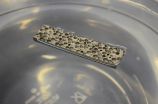(Press-News.org) The time needed to genetically sequence the bacteria causing tuberculosis (Mtb) from patient samples has been reduced from weeks to days using a new technique developed by a UCL-led team. This could help health service providers to better treat disease, control transmission of this infection, and monitor outbreaks.
Tuberculosis (TB) disease rates in some parts of London are as high as in Sub-Saharan Africa, and drug-resistant strains are becoming increasingly common. These require specific treatments, and if doctors know that a bug is resistant they can start therapy earlier, often leading to better outcomes.
Whole genome sequencing reveals the complete genetic (DNA) sequence of an Mtb sample, in many cases pinpointing drug resistance mutations so that appropriate treatments can be given. However, this process currently takes weeks because samples need to be grown in the laboratory before there is enough genetic material to measure.
The new method, published in the Journal of Clinical Microbiology, allows scientists to enrich Mtb DNA directly from patient sputum (mucus) samples. This means that the samples can be sequenced and analysed straight away, avoiding the need to spend weeks growing them in the lab. The work was done as a collaboration between the researchers at UCL, Oxford Gene Technology (OGT), CLC bio-Qiagen and the Erasmus University Medical Center in Rotterdam, who are part of the European Union FP7-funded PATHSEEK consortium.
"Using the conventional methods, patients with resistant TB would need to wait for up to six weeks for antibiotic resistance testing," says senior author Professor Judith Breuer (UCL Infection & Immunity). "In that time, they may be taking drugs that are suboptimal or suffer unnecessary and unpleasant treatment side effects. Our technique and the associated software could reduce testing for antimicrobial resistance to a few days, allowing doctors to give precise antimicrobial treatment earlier than is currently possible."
To extract Mtb from sputum samples, the researchers used probes made of ribonucleic acid (RNA) molecules, engineered to bind to Mtb DNA. The method was tested on 34 routine samples taken from patients in London and Lithuania, where resistant Mtb strains are a significant problem. The sequencing results from sputum matched perfectly with those from the relevant cultured isolates.
"As well as delivering personalised treatments to patients, the tests could also be used to precisely track the spread of TB," explains co-lead author Dr Josephine Bryant (UCL Infection & Immunity). "With rapid sequencing available it would be possible to trace TB infections in communities, or to identify a few highly infectious people, sometimes called 'super-spreaders'. If public health officials can identify these individuals faster and stop them from spreading the disease, control and prevention of future outbreaks could be improved."
As part of the PATHSEEK project, the technique has also been applied to other infections including chlamydia, HIV, hepatitis, herpes, influenza A, norovirus and cytomegalovirus. Although a lot of infections can be treated with antimicrobials, resistance is a growing problem in the UK and globally. Diagnostic techniques that enable more precise treatments to be given earlier could help to combat drug resistance in a wide range of infections, not just TB.
Dr John Anson, Executive Vice President R&D at OGT added: "It is a privilege to be involved with the PATHSEEK project which is yielding such fruitful results, and to play an active role in developing new techniques for the rapid detection and characterisation of such important diseases."
The team hope to further refine the technique in future, to make it cheaper and simpler so that it could be used in countries with less economically-rich healthcare systems where drug-resistant TB is common.
INFORMATION:
A new study published today in the journal Addiction has compiled the best, most up-to-date evidence on addictive disorders globally. It shows that almost 5% of the world's adult population (240 million people) have an alcohol use disorder and more than 20% (1 billion people) smoke tobacco. Getting good data on other drugs such as heroin and cannabis is much more difficult but for comparison the number of people injecting drugs is estimated at around 15 million worldwide.
The "Global Statistics on Addictive Behaviours: 2014 Status Report" goes further in showing that ...
Roughly 1 in 4 women having breast conserving surgery (BCS) return to the surgical suite for further resection because of cancerous tissue left behind due to unclear margins. Investigators at the Optics in Medicine Lab at Dartmouth's Thayer School of Engineering and Norris Cotton Cancer Center, led by Brian W. Pogue, PhD and Keith Paulsen PhD, with first author and PhD candidate David M. McClatchy III, devised a novel approach to perform near infrared (NIR) optical measurements of resected breast tissue after the margins have had their traditional marking by the surgeon ...
(Boston)--Repetitive head injuries that occur during contact sports and military service may accelerate the aging process by increasing the build-up of beta-amyloid in the brain, leading to worse disease and an increased likelihood of developing dementia. In particular, boxers fared the worst among athletes and military veterans with a history of head injuries.
These findings, which currently appear online in the journal Acta Neuropathologica, is the first to establish the age-dependent deposition of beta-amyloid in chronic traumatic encephalopathy (CTE), and may lead ...
URBANA, Ill -- Wetlands created 20 years ago between tile-drained agricultural fields and the Embarras River were recently revisited for a new two-year University of Illinois research project. Results show an overall 62 percent nitrate removal rate and little emission of nitrous oxide, a potent greenhouse gas.
"Slowing down the rate of flow of the water by intercepting it in the wetland is what helps to remove the nitrate," says Mark David, a University of Illinois biogeochemist in the College of Agricultural, Consumer and Environmental Sciences. "The vegetation that ...
The act of identifying a perpetrator does not just involve memory and thinking, but also constitutes a moral decision. This is because, by the act of identifying or not identifying someone, the eyewitness runs the risk of either convicting an innocent person or letting a guilty person go free.
In an article published recently in Archives of Scientific Psychology, Spring et al. (2015) discuss two studies in which children and adolescents of different ages watched a film involving a potential wrong-doing: throwing a lit birthday cake into a wastebasket, either with or without ...
A new study published today in the journal Addiction has compiled the best, most up-to-date evidence on addictive disorders globally. It shows that almost 5% of the world's adult population (240 million people) have an alcohol use disorder and more than 20% (1 billion people) smoke tobacco. Getting good data on other drugs such as heroin and cannabis is much more difficult but for comparison the number of people injecting drugs is estimated at around 15 million worldwide.
The "Global Statistics on Addictive Behaviours: 2014 Status Report" goes further in showing that ...
BUFFALO, N.Y. -- Tinnitus is the most common service-related disability for veterans returning from Iraq and Afghanistan. Often described as a ringing in the ears, more than 1.5 million former service members, one out of every two combat veterans, report having this sometimes debilitating condition, resulting in more than $2 billion dollars in annual disability payments by the U.S. Department of Veterans Affairs.
Tinnitus is largely a mystery, a phantom sound heard in the absence of actual sound. Tinnitus patients "hear" ringing, buzzing or hissing in their ears much like ...
Transgenic Huntington's disease monkeys show similarity to humans with Huntington's in their progressive neurodegeneration and decline of motor control, scientists from Yerkes National Primate Research Center, Emory University, report.
These findings are promising for developing a preclinical, large animal model of Huntington's disease for assessing new therapeutics, which could ultimately provide better treatment options, including altering the course of the disease.
In this first multiyear study on a transgenic nonhuman primate model for Huntington's, lead author ...
DURHAM, N.C. -- Lemur girls behave more like the guys, thanks to a little testosterone, according to a new study.
Males rule in most of the animal world. But when it comes to conventional gender roles, lemurs -- distant primate cousins of ours -- buck the trend.
It's not uncommon for lady lemurs to bite their mates, snatch a piece of fruit from their hands, whack them in the head or shove them out of prime sleeping spots. Females mark their territories with distinctive scents just as often as the males do. Males often don't take their share of a meal until the females ...
BROOKLYN, New York -- Researchers have demonstrated a new metal matrix composite that is so light that it can float on water. A boat made of such lightweight composites will not sink despite damage to its structure. The new material also promises to improve automotive fuel economy because it combines light weight with heat resistance.
Although syntactic foams have been around for many years, this is the first development of a lightweight metal matrix syntactic foam. It is the work of a team of researchers from Deep Springs Technology (DST) and the New York University ...


